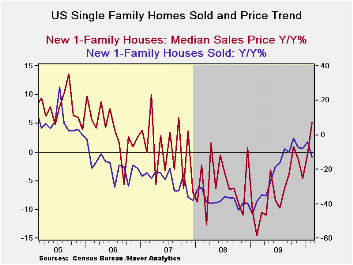 Global| Mar 24 2010
Global| Mar 24 2010New Home Sales Drop But Prices Rise – Go Figure
Summary
If there is such a thing as a classic signal for a weather effect this is it: sales fall but Yr/Yr prices rise. Housing prices are not seasonally adjusted. They do exhibit some pretty pronounced seasonal patterns, however. Yr/Yr [...]

If there is such a thing as a classic signal for a weather effect this is it: sales fall but Yr/Yr prices rise. Housing prices are not seasonally adjusted. They do exhibit some pretty pronounced seasonal patterns, however. Yr/Yr percentage changes purge seasonality from the data but make it harder to detect short term changes.
In February we have a 2.2% month-to-month drop in new home sales led by a 20% drop in the wintry NE and a minus 18% result in the snow-covered Midwest, compared to a -4.6% drop in the South and a 20.8% gain in the West. The winter profile of losses/gains makes sense. The turn up in prices shows median price gains Yr/Yr for the first time since October of last year and only the third Yr/Yr rise for median prices in 27 months. Average prices are up for three-months running; the last three-month rise in prices ended in June of 2007.
Despite some sharp improvement in economic conditions the huge fiscal help offered by the government has reached its limits. Attempts to pull back and inject fiscal prudence are not being well-accepted in France.
On balance this report really has the feel of a report disrupted by weather in a market that is getting back in shape. The existing home sales report was not as clean in producing its weather effects since the lags are longer. Homebuilders count a sale as consummated when the contract is signed. The NAR calls a deal a deal when it closes, meaning that monies are exchanged which means that we must wait out the financing process which these days is running three months in many places.
I find this report on new home sales very encouraging since, once prices are no longer falling, the real impediment to buying is gone. And home affordability is still very high.
| New Single Family Home Sales | |||||||
|---|---|---|---|---|---|---|---|
| As of: Feb.10 |
Momentum: Annualized Rates Of Change | Prices | |||||
| Total | N.E | MidW | South | West | Median | Average | |
| Month-to-month percent change | |||||||
| Feb.10 | -2.2% | -20.0% | -18.0% | -4.6% | 20.8% | 6.1% | 5.1% |
| Jan.10 | -8.7% | -10.3% | 2.0% | -12.6% | -6.1% | -5.2% | -3.8% |
| Dec.09 | -4.7% | 30.0% | -31.0% | -5.4% | 7.9% | 0.2% | 1.8% |
| Annualized Rates | |||||||
| Total | N.E | MidW | South | West | Median | Average | |
| 3-Mo | -59.7% | -26.7% | -169.0% | -84.3% | 89.5% | 3.1% | 12.0% |
| 6-Mo | -49.0% | -44.4% | -53.6% | -59.6% | -27.8% | 13.4% | 20.2% |
| 1-Yr | -13.0% | 0.0% | -18.0% | -29.5% | 34.8% | 5.2% | 9.3% |
| Cumulative prices change since same mo of | SAAR | ||||||
| 2008 | 2007 | 2006 | 2005 | 2004 | 5-yr% | 10-Yr% | |
| Avg | 9.3% | -6.2% | -12.1% | -8.2% | -2.2% | -0.5% | 3.6% |
| Median | 5.2% | -10.1% | -12.1% | -12.1% | -7.1% | -1.5% | 3.1% |
| Yr Yr price changes by 12-mo period | |||||||
| Avg | 9.3% | -15.5% | -5.9% | 3.9% | 6.0% | ||
| Median | 5.2% | -15.3% | -2.0% | 0.0% | 5.0% | Median | Average |
| Feb.10 | Max Drop in Current Prices Since 2000 | -16.0% | -14.2% | ||||
| &Drop is calculated from higest point in period | |||||||
Robert Brusca
AuthorMore in Author Profile »Robert A. Brusca is Chief Economist of Fact and Opinion Economics, a consulting firm he founded in Manhattan. He has been an economist on Wall Street for over 25 years. He has visited central banking and large institutional clients in over 30 countries in his career as an economist. Mr. Brusca was a Divisional Research Chief at the Federal Reserve Bank of NY (Chief of the International Financial markets Division), a Fed Watcher at Irving Trust and Chief Economist at Nikko Securities International. He is widely quoted and appears in various media. Mr. Brusca holds an MA and Ph.D. in economics from Michigan State University and a BA in Economics from the University of Michigan. His research pursues his strong interests in non aligned policy economics as well as international economics. FAO Economics’ research targets investors to assist them in making better investment decisions in stocks, bonds and in a variety of international assets. The company does not manage money and has no conflicts in giving economic advice.






